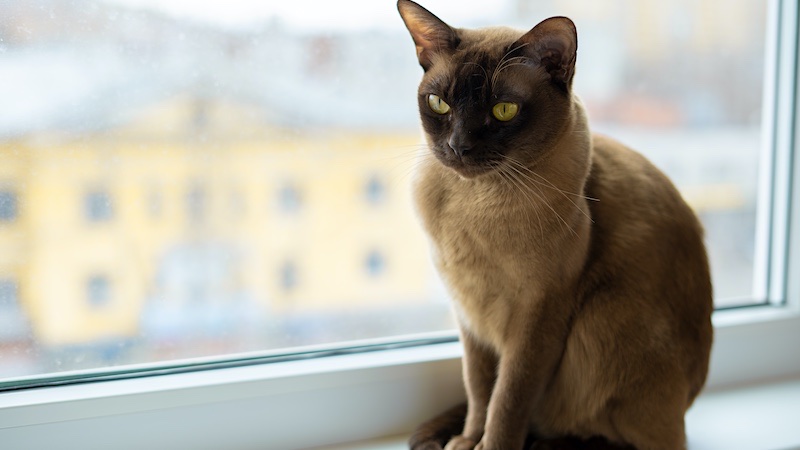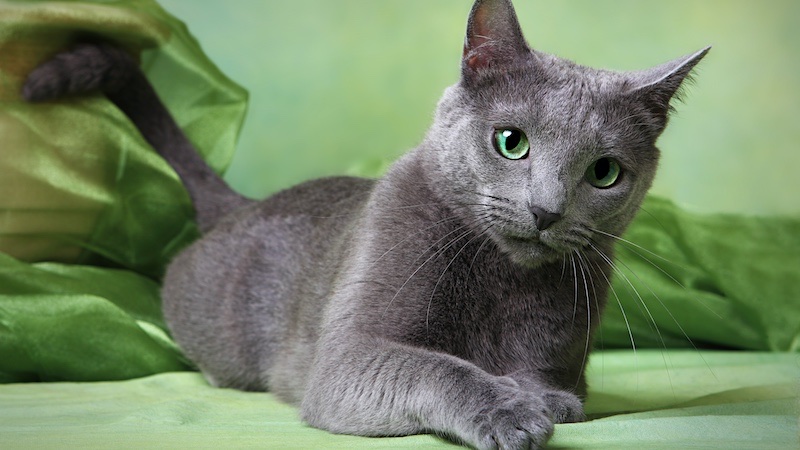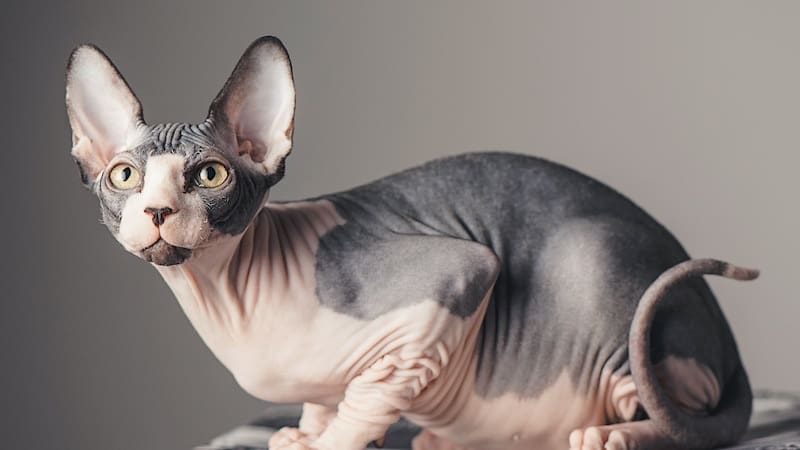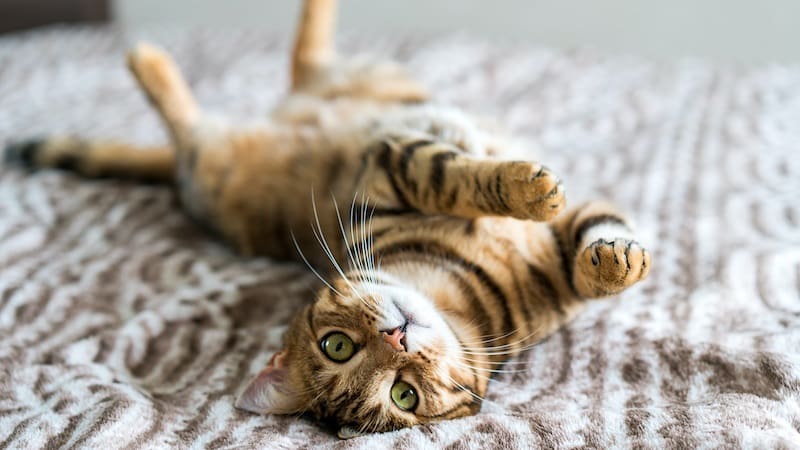Are you looking for a furry companion to share your home with? There are many indoor cat breeds but each has its own traits and requirements.
Choosing which cat breed is going to live in your home can be overwhelming as there are so many wonderful options out there. Here, I’ll explore 12 of the best indoor cat breeds and discuss why they may or may not be perfect for you.
Persian Cat

The Persian cat is a long-haired breed that originated in Iran. They are one of the oldest breeds of cats, with records dating back to 1620. Persians have round faces and large eyes, giving them an endearing appearance. Their fur can come in many colors and patterns, including solid white, black, blue-gray or tabby.
Temperament and Personality: Persian cats are known for their gentle personalities and sweet dispositions making them great indoor cats. They tend to be quite calm and affectionate towards their owners, making them ideal companions for those looking for a low-maintenance pet. However they do require regular attention from their owners as they can become easily bored if left alone too often.
Health Considerations: Persian cats may be prone to certain health issues due to their flat face shape which can cause breathing difficulties or eye problems such as tear staining or ulcers on the cornea. Regular visits to the vet are recommended in order to monitor any potential health issues that may arise over time.
Grooming Requirements: Due to its long coat, the Persian cat requires daily grooming sessions in order keep it clean and free from tangles or mats that could cause discomfort or skin irritation when not taken care of properly . Brushing should also be done regularly using a soft brush specifically designed for long haired cats . Bathing should only be done when necessary as too much bathing can strip away natural oils from its fur causing dryness .
One advantage of owning this breed is that they typically don’t need much exercise, so you won’t have to worry about taking your cat out on walks every day like other breeds might require. On the downside, because these cats have such luxurious coats, they will require more frequent grooming than other short-haired breeds which could mean additional costs associated with keeping up with regular brushing sessions.
Recap: Persian cats are gentle and affectionate, making them ideal indoor companions. However they require grooming due to their long coats and may be prone to certain health issues. Daily brushing, occasional bathing and vet visits should all be taken into consideration when caring for a Persian cat.
Ragdoll Cat

The Ragdoll cat is a large breed of indoor cat with an easy-going temperament and a thick, plush coat. They have long legs and tails, round faces, and deep blue eyes. Their coats come in many colors including seal point, blue point, chocolate point, lilac point, redpoint and creampoint.
Temperament and Personality: Ragdoll cats are known for being incredibly affectionate and loyal to their owners. They enjoy spending time with people but can also be quite independent at times. They are gentle cats that love to cuddle up on laps or sleep next to their owners in bed.
Health Considerations: Ragdolls may be prone to certain health issues such as heart disease or kidney problems due to their large size. It’s important for them to receive regular veterinary checkups so any potential issues can be caught early on before they become serious problems.
Grooming Requirements: As mentioned earlier, Ragdolls require regular grooming due to their thick coats which can easily become matted if not brushed regularly. Brushing should take place at least once per week using a slicker brush or comb designed specifically for cats with long hair like the Ragdoll breed has. Additionally it’s important that you trim your cat’s nails every few weeks so they don’t get too sharp or uncomfortable when walking around the house or playing outside in the garden .
Recap: Ragdolls are a large cat breed with an affectionate temperament and thick coat. They require plenty of grooming, veterinary checkups, and nail trimming to ensure their health and well-being.
Maine Coon Cat

If you want a large sized cat breed the Maine Coon is the largest of all the domesticated cat breeds, with a thick coat that comes in many colors and patterns. They have long, bushy tails and large ears which are often tufted at the tips. Their fur can range from short to medium length depending on their age and sex. Males tend to be larger than females, weighing up to 20 pounds when fully grown.
Temperament and Personality: Maine Coons are known for being intelligent, playful cats that make great family pets due to their friendly nature and loyalty towards their owners. They enjoy interacting with people as well as other animals such as dogs or other cats in the household.
They also love exploring new places so it’s important to provide them with plenty of stimulation through toys or activities like chasing laser pointers around the house.
Health Considerations: As with any pure cat breed, regular vet check-ups are essential for maintaining good health throughout its life span. In addition, Maine Coons may be prone to certain health issues such as hip dysplasia or heart problems so it’s important to keep an eye out for any signs of illness or discomfort in your pet.
Grooming Requirements: Grooming is required to keep their coats in good condition; brushing once a week should suffice but more frequent brushing may be necessary during shedding season (usually spring). It’s also important not forget about trimming nails every few weeks too.
The pros of owning a Maine Coon Cat include having an intelligent companion who loves spending time with you; they are loyal friends who will always greet you when you come home from work each day.
On the downside, however, they do require quite a bit more maintenance than some other breeds due to needing a lot of grooming sessions as well as potential health issues which could arise over time if not monitored closely by your vet.
Recap: Maine Coons make great family pets due to their friendly nature and loyalty, but require more maintenance than other breeds with weekly grooming and vet check-ups necessary. Grooming: brush once a week, trim nails every few weeks; Health: watch for signs of illness or discomfort.
British Shorthair Cat

The British Shorthair is an ancient breed of cat that has been around since the Roman Empire era. They have a stocky build, with short fur that comes in many colors and patterns. They are known for their round faces and large eyes, giving them a teddy bear-like appearance.
Temperament and Personality: British Shorthairs are known to be very laid back cats who enjoy snuggling up with their owners but still have plenty of energy when it’s time to play. They tend to get along well with other pets in the household, as long as they’re given enough attention from their owners.
Their easy going nature makes them one of the best cat breeds for first-time owners.
Health Considerations: As with any pet, regular vet visits should be scheduled to ensure your pet stays healthy. This breed may be prone to certain health issues such as obesity or dental problems due to its stocky build and short muzzle. It’s important to keep an eye out for any signs of illness or discomfort so you can address them quickly if needed.
Grooming Requirements: Brushing once or twice a week will help remove dead hair and distribute natural oils throughout the coat which helps prevent matting and tangles. Nail trimming should also be done regularly, as well as ear cleaning every few weeks depending on how dirty they become over time.
The pros of owning a British Shorthair Cat include having a loyal companion who loves cuddles as much as playing, being able to groom them easily due to their short fur, not needing too much exercise and they come in many different colors so you can find one that fits your style perfectly.
Some cons include potential health issues related specifically this breed, possible shedding (although minimal), potential litter box odor if not cleaned often enough and some people might find them too lazy compared other cat breeds such as the Siamese breed.
Recap: This ancient breed of cat that has a stocky build, short fur and friendly temperament. They require twice weekly grooming and vet visits, but the pros outweigh the cons: loyal companion, easy to groom, low exercise needs and come in many colors.
Siamese Cat

The Siamese cat is a medium-sized breed that originated in Thailand. They have a distinctive look with their sleek, slender bodies and pointed features. Their coats are usually short and come in shades of cream, brown, or blue. They also have striking blue eyes that make them stand out from other breeds.
Temperament and Personality: Siamese cats are known for being very vocal cats who love attention from their owners. They can be quite independent at times but they still enjoy spending time with people. They tend to bond closely with one person in particular but will happily accept affection from anyone willing to give it.
Health Considerations: As with any breed of cat, there are certain health issues that may affect the Siamese breed more than others. These include eye problems such as glaucoma or progressive retinal atrophy (PRA), respiratory issues due to their flat faces, and kidney disease which is common among older cats of this breed. Regular vet checkups can help identify any potential problems early on so they can be treated promptly if necessary.
Grooming Requirements: Since the Siamese has a short coat, brushing once or twice per week as well as occasional baths when needed to remove dirt and debris from the fur. Nail trimming should also be done regularly since these cats tend to scratch furniture often.
Pros of owning a Siamese cat include having an intelligent companion who loves attention. Cons include potential health concerns related specifically to this breed such as eye problems or kidney disease.
Recap: The Siamese cat is a popular breed known for their intelligence and affection. They require frequent grooming, and may be prone to certain health issues such as eye problems or kidney disease. Pros: Intelligent companion who loves attention; Cons: frequent grooming & potential health concerns.
Honourable Mentions
Whilst I consider the above 5 the best indoor cat breeds, the following 7 also have personalities that might be suitable for your particular needs and environment.
Burmese Cat

Burmese cats are highly intelligent felines that are known for their playful and loyal personalities. With proper care, they can be great companions and wonderful family pets.
Burmese cats do need plenty of stimulation, so it’s important to provide them with lots of toys and activities to keep them entertained. They also love human interaction, so it’s important that someone in the household is home enough to devote to bonding with the cat.
Burmese cats are also very social animals so they do best in homes where there is already another pet or two in residence. You shouldn’t consider a Burmese cat if he will be left alone all day.
Russian Blue Cat

The Russian Blue cat is known for its elegant, graceful look and its sweet temperament, which makes it a popular choice as an indoor pet.
The Russian Blue cat has a striking appearance, with bright green eyes and a silver-blue coat that stands out from other cats. Its unique coloring also gives it the nickname “the Archangel Cat” due to its resemblance to the blue skies of Archangel in Northern Russia.
Despite their exotic looks, these cats are incredibly loyal and affectionate when they bond with their owners. They like to play and climb high.
Scottish Fold Cat

Scottish Fold cats are both intelligent and independent, meaning that they can entertain themselves through activities such as stalking their toys or watching birds out of the window. Moreover, they have an affectionate personality, making them easy to get along with and cuddly companions for those who need extra love.
As well as their unusual folded ears, Scottish Fold cats are also known for their quiet nature. They do not meow too much – rather they tend to purr more than other breeds. This makes them well suited for living in apartments without disturbing neighbors or family members with loud noises.
You can get both short haired and long haired Scottish fold cats.
Furthermore, due to their diminutive size, these cats require very little space to move around in and don’t require large outdoor enclosures like some other breeds of cat do.
Devon Rex Cat

The Devon Rex cat is known for being highly active and quite intelligent, making them ideal for an indoor lifestyle.
Devon Rex cats are usually very affectionate with their owners and enjoy playing interactive games such as fetch or chasing toys. They typically get along well with children and other pets, making them one of the best indoor cats for family life.
They also tend to be quite adaptable when it comes to changing environments so they don’t require too much adjustment time when transitioning from outdoor life to indoor life should you be looking for indoor cats for adoption.
The Devon Rex coat is also low maintenance compared to other breeds as they only need weekly brushing – great news for busy pet owners.
Singapura Cats

Although still relatively rare so can be hard to find, Singapura cats make a great option for an indoor cat, thanks to their friendly and easy-going nature. These small cats are known for being calm, gentle, and affectionate. I believe Singapura cats are the smallest cat breed in the world.
These kitties are also incredibly intelligent. They can pick up on tricks quickly and love to explore their environment – making indoor activities such as puzzle toys or playtime with other cats a great way to keep them entertained. Plus, Singapuras have short hair which means less shedding so it’s easier to keep your home clean.
If you’re home all day and looking for a loyal companion who will follow you from room to room and loves cuddles too then the Singapura is definitely worth considering.
Sphynx Cats

The Sphynx cats unique appearance is certainly charming – with their short fur and pointed ears, they stand out from the crowd. But beyond looks, this cat breed is known for being a smart and loving companion.
A Sphynx cat will quickly become an important part of the family and form strong bonds with its owners. They rarely vocalize, making them perfect for those looking for a quiet pet that won’t disturb the neighbors.
Bengal Cat

Bengal cats are one of the most popular cat breeds in the world. They are known for their beautiful coat patterns and curious personalities that make them a joy to be around. But when it comes to keeping them as indoor pets, many cat lovers have concerns about whether they’ll be happy living inside all the time.
The truth is, Bengal cats can make great indoor pets! They’re intelligent, playful and love human interaction. With plenty of toys, a cat wheel and scratching posts available, they’ll have no trouble staying active while indoors. Plus, unlike other breeds that can become lazy and overweight when kept inside all day, Bengals are naturally active and will enjoy jumping around your home to burn off energy.
As an added bonus the Bengal cat is considered hypoallergenic as it produces fewer allergens than other breeds of cat.
FAQ
Is it OK to have an indoor only cat?
Yes, it is perfectly acceptable although some cat breeds take to the indoor life better than others. Indoor cats can lead healthy and happy lives with the right care and attention.
Providing a safe environment for your cat indoors means they are less likely to be exposed to dangers such as traffic or other animals that could cause them harm.
Indoor cats have a much greater life expectancy when compared to outdoor cats too.
Regular veterinary check-ups, plenty of toys and activities, proper nutrition, and regular grooming, physical and mental stimulation will all help keep your indoor cats healthy and contented.
With the right love and care, an indoor only cat can live a long life full of joy.
Can any cat be an indoor cat?
Yes, any cat can be an indoor cat. However, it is important to remember that cats are naturally curious and active animals who need stimulation and exercise. Therefore, if you plan on keeping a cat indoors it is essential to provide them with plenty of toys and activities to keep them entertained.
Additionally, providing scratching posts or other objects for the cat to scratch will help prevent furniture from being damaged by their claws. Finally, regular vet check-ups should be scheduled in order to ensure your pet’s health remains optimal while living indoors.
Which are the calm indoor cat breeds?
The calmest house cats are generally considered to be the Ragdoll, British Shorthair, and Maine Coon. These breeds tend to have gentle personalities and enjoy spending time with their owners. They also adapt well to living indoors and don’t require a lot of exercise or stimulation.
The Ragdoll is known for its affectionate nature while the British Shorthair has an even-tempered personality. The Maine Coon is loyal and intelligent, making it a great companion for any home. All three breeds make excellent indoor cats and family pets that can provide years of love and companionship.
Conclusion
Indoor cats can make great companions and are a wonderful addition to any home. With the right breed of cat, you can find a loyal friend that will bring joy into your life for many years.
Whether it’s the Persian Cat with its luxurious coat or the Ragdoll Cat with its gentle personality, there is an indoor cat breed out there for everyone. The Maine Coon Cat is perfect for those who want a larger pet while the British Shorthair Cat makes an ideal lap cat. Finally, Siamese Cats are known as talkative cats and make excellent conversation partners!
No matter which indoor cat breeds you choose, they all have unique personalities that will bring warmth and love into your home.





